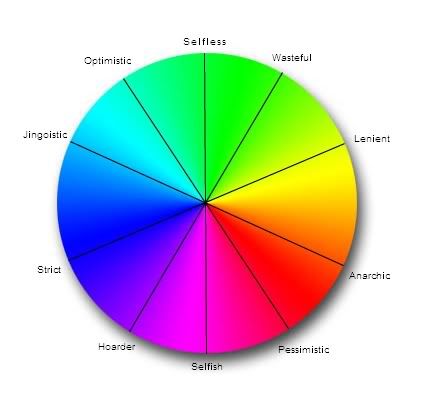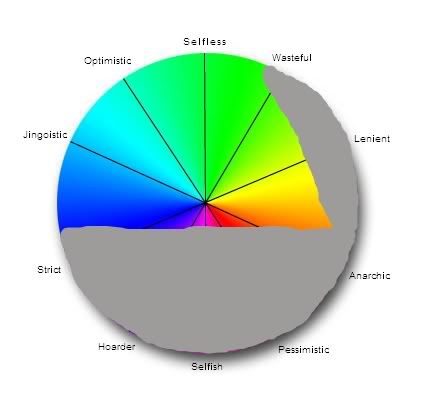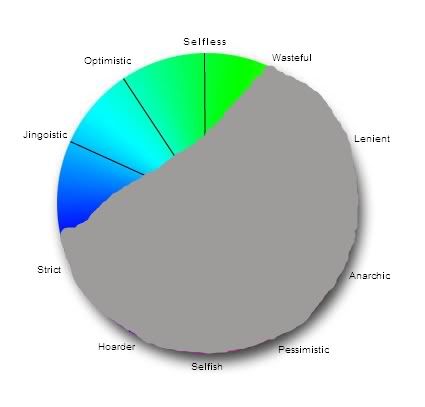I have this batshit theory that character traits may actually work across a multi-dimensional spectrum, and that formalizing such a spectrum may help us more easily understand and identify character type and... well, honestly I think it would help with a lot of things. It's probably too complex for someone like me to be able to define, but I could at least get the ball rolling.
Imagine something like a color wheel, but with gradients of personality instead of hue. There's basically an infinite amount of sets of axes that could be plotted around the center point (which I guess would symbolize the most balanced/boring person in existence), with each axis symbolizing one extreme versus its opposite (selfish vs. selfless, fearless vs. paranoid, etc). This is kind of headed in the right direction, but it seems too focused on defining traits as inherently "positive" or "negative" to feel very accurate or useful to me.
But anyway, just like the code E62802 defines a specific point on a color wheel, so could the name "Jack Sparrow" define a specific point on the personality wheel. If you can see the point at which their personality resides, you immediately discover a lot about them. Their opinions, ideals, how they would react to certain things. Or - more importantly, if you're a creator - you could use the chart to get a sense of what needs to be shown to the audience, and what can remain a mystery.
So here's a way-oversimplified mock-up:
It's pretty arbitrary and comes nowhere close to describing the full spectrum of our personalities, but still, for example.
Let's say we start watching a film. In the first scene, the protagonist gives some bum five bucks. Okay, the guy's not too selfish. So if we're following along on the wheel, we could black out some areas where we're pretty sure his personality won't fall:
(We don't go all the way up to the midpoint, since a trait in the center can swing either way depending on the situation.)
In the next scene, a biker narrowly misses hitting him on a busy street. Our protagonist yells "Watch it, buddy". Fairly normal behavior, sure, but not exactly lenient. So we can further amend our wheel:
The next scene is on the bus, where our protagonist strikes up a conversation with a stranger. "I just lost my job and can't afford medication for my wife," says the stranger. "With the economy this bad, I don't know how I can hope to keep her healthy."
"Don't worry, sir," says our protagonist, "something will turn up, you'll see. No problem is insurmountable."
Pretty damn optimistic, right? OK, we're getting a good bead on this character now:
Finally our protagonist arrives at a nondescript old building. As he enters and prepares for something, we realize he's at his job. He cleans himself up and heads into a dark room... where a bloody, broken man sits tied to a chair. Our protagonist sharpens a knife. Only shit, this guy is a TORTURER. And, we find out, he works for a shadowy right-wing group that has taken domestic terrorist watch into its own hands. As he approaches his quarry, we make the final big change to our chart:
Didn't see that one coming, huh?
But it's pretty much in line with what we've seen so far, and that's the power of the whole thing. Once you have a good idea of the spot your character occupies on the chart, it becomes much easier to decide what to tell your audience, and when to tell it for maximum dramatic effect.
If limited stories (i.e. feature films) are about the protagonist overcoming a major character flaw, then open-ended ones (i.e. television series) are about slower character evolution. Your movie hero will (ideally) jump from one spot on the chart to another by the end of the film, while serial characters will move slowly along different axes as they encounter new situations. And all of this can be easily charted and predicted in similar ways to what we've just done.
The question is, I guess, how far do we take this methodology? How much can, or should, we reduce our personalities to geometric formulas and loci? And, someone who's not me, please weigh in: does this idea even work in the first place?
Monday, May 11, 2009
The Geometry of Identity
Subscribe to:
Post Comments (Atom)

No comments:
Post a Comment